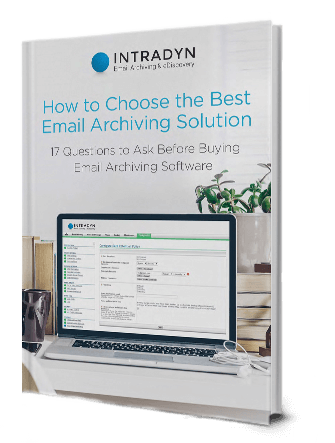13 Key Email Archiving Best Practices That You Need to Know

In today’s heavily regulated, litigation-happy world, email archiving isn’t just nice to have for businesses, it’s an absolute need to have. As a result, most companies have already invested in an email archiving solution — but that doesn’t necessarily mean that their current solution or archiving policies are as effective as they could or should be.
Want to be more effective? We’ve created a list of the top 13 email archiving best practices to help you get on track.
What Is Email Archiving?
First, let’s level-set — what is email archiving and why does it matter?
Email archiving is the systematic process of capturing, storing and managing emails and the information they contain in a secure, searchable way for extended periods of time. It ensures that any emails your business retains are kept in their original format and logically organized, often to meet regulatory requirements, legal obligations and company policies.
There are a few reasons why organizations should invest in email archiving:
It supports compliance, ensuring that organizations meet the retention requirements of various laws and industry regulations.
It streamlines eDiscovery, enabling businesses to surface critical information and respond to eDiscovery requests in a timely manner.
It preserves key information, protecting it from accidental deletion, data loss or corruption.
It creates a historical record of communication, which is valuable for conducting internal audits, resolving disputes, supporting knowledge transfer and providing context behind business decisions and agreements.
It allows for more effective data management, reducing the strain on email servers and storage systems, which can improve system performance and reduce operating costs.
It supports business intelligence, providing organizations with vast quantities of email data that they can analyze to gain insights into market trends, customer behavior, employee preferences and more, all of which can inform business strategy.
Invest in the Right Solution
Email archives take up an exceptional amount of storage space. Depending on the size of your business and the number of users whose emails you intend to archive, you could potentially be looking at one or more terabytes of mailbox data — an amount that will only increase and place additional strain on your servers as your business grows.
If you’re shopping for your very first email archiving system or simply looking to replace your existing solution, one of the key email archiving best practices to keep in mind is to find a solution with a storage capacity that can scale with your business — that way, you’ll never have to worry about receiving the dreaded “Out of Storage” message.
Triple-check Laws & Regulations
Depending on which industry your business operates in, you could be subject to a series of rules and regulations that outline specific requirements for record retention. For example, health care organizations are subject to the Health Information Portability and Accountability and the Health Information Technology for Economic and Clinical Health Acts, which set strict parameters around how Protected Health Information can be electronically transmitted and how these correspondences must be archived.
Failure to comply with these and other regulations could result in damage to a business’ reputation, millions of dollars in penalties and even prison time. Therefore, it’s in every business’ best interest to carefully review all applicable rules and regulations and to ensure that their email archiving system is compliant.
Consult Your Legal Team
Establishing email retention policies is a best practice in-and-of itself, but one of the most important email retention best practices is to consult your legal team before implementing them. Your legal team knows better than anyone which regulations your business is subject to, the specific language used in those regulations, their record retention requirements and so on — after all, it is their job to ensure that your company is legally protected — so lean on that resource as much as possible when drafting retention policies.
Create a Retention Policy “A-Team”
Your legal team isn’t your only resource when creating retention policies. Per email retention policy best practices, your stakeholders, finance team, engineers, investors, production team and administration team should all play a role in defining policies to ensure that every department and level of business is represented and on the same page when it comes to retention periods and document storage. Consider pulling a member of each group or department to form an A-team responsible for weighing in on this important matter.
Establish a “High Water Mark”
The recommended retention period for emails can vary wildly from one regulation to the next, even for different regulations that apply to the same industry. Many employees struggle to follow a single email retention policy, let alone multiple policies with different retention periods, so it’s best practice to create policies with a “high-water mark” retention period — that is, a retention period that meets the requirements for as many regulations as possible.
For example, if your business is subject to three major regulations that require one-, three- and seven-year retention periods, respectively, it’s best to optimize for all three at the same time by establishing a high-water mark retention of seven years. That way, you can simplify compliance for your employees and ensure that all of your bases are covered.
Make Retention Easy to Understand
Speaking of making it easier for employees to observe email retention policies and periods, another way to make the process more straightforward is to make retention policy schedules as simple as possible. The last thing your employees want to do is pore over page after page of policy documentation, and for good reason: It eats up valuable time that could be spent on other, more business-critical tasks. By condensing schedules to a page or less and making sure that they’re easily scannable, you can save time and guarantee that the right emails are entered into record.
Regularly Update Your Policies
Federal laws and agency regulations concerning records retention can change from year to year, and if your business’ email retention policies are up to date with the latest changes, you could be in for a nasty surprise. Annually reviewing and updating your existing policies with your legal team and other members of your A-team is a great way to ensure that they remain up to code — and that your business remains legally compliant.
Broadcast Policy Changes
An updated email retention policy isn’t any good if the people who are supposed to follow it aren’t aware of the changes that were made. After you’ve updated your policies, make sure to notify your employees of any changes made. In the interest of keeping your employees informed, explain the reason (or reasons) behind the change and where they can access update email retention policy schedules and other documentation.
Automation Retention
One of the most important features of any archiving solution is the retention policy feature. If the archiving solution does not have this feature than it if not worth a dime. Once you documented the retention policy for your organization, you will find that each department have different requirements. The emails send by the billing department and client support department have very different retention requirements.
You will want an archiving solution that can automatically remove emails from the archiving solution after a certain period. For example, the archiving solution will remove the support email after 30 days, sales email after five (5) years, human resource emails after seven (7) years. And never removes any email which is under litigation.
Avoid Using PST Files
Most federal rules and regulations stipulate that the data contained within all archived emails must be tamper-proof, which becomes an issue if your employees have a habit of archiving PST files and backing them up onto a hard drive. Since PST files are not tamper proof, should your business face litigation, it would be difficult — if not impossible — to prove that the files hadn’t been edited. This is just one item on a laundry list of reasons why employees should be discouraged from saving emails as PST files: PST files are also prone to corruption, are device-specific, are often used to sidestep retention policies, are restricted to Outlook and so on. The moral of the story here is, if following email archiving best practices is important to you, you need to cut ties with PST.
Automate Archiving & Legal Holds
Now that you have solid retention policies in place, you’re ready to automate the email archiving process. Most modern archiving solutions have the ability to perform real-time fetching — that is, to capture all incoming and outgoing emails in real-time and store them in a secure, tamper-proof repository — thereby eliminating the time and stress associated with manual email archiving. Some solutions even extend this automation to the legal hold process, making it easy for businesses to schedule searches and quickly access important data in the event of an eDiscovery request or pending litigation. Automation is your best friend, so use it whenever and wherever you can.
Archive Everything
Most companies already understand the importance and necessity of email archiving but, as text and SMS messages and social media become increasingly popular forms of business communication, they need to look into other types of archiving, as well. If your business currently only archives email, you might want to start researching vendors that offer an all-in-one email, social media and text/SMS message archiving solution.
Know Your Business Challenges
When buying a car, you don’t just jump at the first model the salesperson shows you, right? The same logic applies to email archiving solutions. Although the vast majority of email archiving products on the market boast the same basic feature set, certain solutions are more robust than others or cater to specific business needs.
Whether you’re new to email archiving or simply want to make a switch, before making an investment, evaluate your current and potential future business challenges and how you hope to use email archiving to resolve them. For example, does your business exist in an industry that’s heavily regulated? Have you experienced, or do you anticipate experiencing, frequent litigation? What are your storage capacity needs? Does your business currently have a high volume of PST files? Once you’ve performed a thorough evaluation, you’ll be better prepared to make an informed decision.
Want to learn more email archiving best practices or need assistance finding the right solution for your business? Our team of specialists is at the ready to help you with all of your archiving needs — contact us today to get started!

